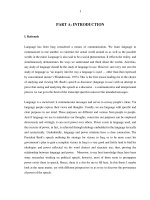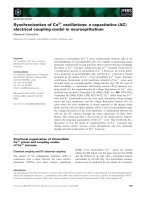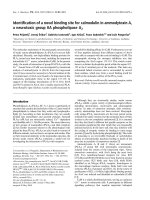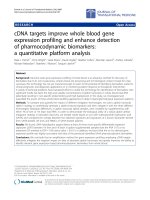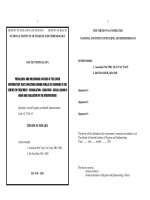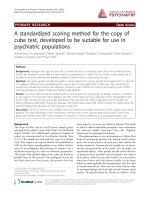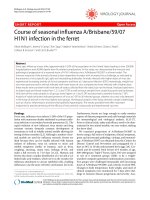Factors of consumers choices a reaveled preferences analysis for 3 in 1 coffee
Bạn đang xem bản rút gọn của tài liệu. Xem và tải ngay bản đầy đủ của tài liệu tại đây (802.4 KB, 108 trang )
UNIVERSITY OF ECONOMICS
HO CHI MINH CITY
VIETNAM
ERASMUS UNVERSITY ROTTERDAM
INSTITUTE OF SOCIAL STUDIES
THE NETHERLANDS
VIETNAM – THE NETHERLANDS
PROGRAMME FOR M.A IN DEVELOPMENT ECONOMICS
FACTORS OF CONSUMER’S CHOICES:
A REVEALED PREFERENCE ANALYSIS FOR
3IN1 COFFEE
BY
NGUYEN VAN VIEN
MASTER OF ARTS IN DEVELOPMENT ECONOMICS
HO CHI MINH CITY, November 2016
UNIVERSITY OF ECONOMICS
HO CHI MINH CITY
VIETNAM
INSTITUTE OF SOCIAL STUDIES
THE HAGUE
THE NETHERLANDS
VIETNAM - NETHERLANDS
PROGRAMME FOR M.A IN DEVELOPMENT ECONOMICS
FACTORS OF CONSUMER’S CHOICES:
A REVEALED PREFERENCE ANALYSIS FOR
3IN1 COFFEE
A thesis submitted in partial fulfilment of the requirements for the degree of
MASTER OF ARTS IN DEVELOPMENT ECONOMICS
By
NGUYEN VAN VIEN
Academic Supervisor:
TRUONG DANG THUY
HO CHI MINH CITY, November 2016
ACKNOWLEDGEMENT
I would first like to thank my thesis supervisor Dr. Truong Dang Thuy of the Vietnam – The
Netherlands Programme (VNP) at Ho Chi Minh City University of Economics. He
consistently allowed this paper to be my own work, but steered me in the right the direction
whenever he thought I needed it.
I acknowledge the contribution of Dr. Nguyen Ba Thanh (IUH) as the second reader of this
thesis, and I am gratefully indebted to him for his very valuable advices on building idea for
this thesis.
I would like to express my gratitude to the VNP officers who were involved in my thesis
process by updating thesis schedule and providing good condition for my research process.
Without their passionate participation, the thesis process could not have been successfully
conducted.
Finally, thanks are also due to my classmates for providing me with unfailing support and
continuous encouragement throughout my years of study and through the process of
researching and writing this thesis. This accomplishment would not have been possible without
them. Thank you.
Nguyen Van Vien
Ho Chi Minh City, November 2016
Page i
ABSTRACT
3in1 coffee is known as an important product of instant coffee market in Vietnam, especially
in Ho Chi Minh City. The reason of that comes from the benefits which 3in1 coffee brings to
consumers in term of convenience, product quality, and appropriate price. In the above context
of 3in1 coffee market, the main objective of this study is to identify the determinants of
consumer’s choices in 3in1 coffee market such as price, main ingredients, packaging,
manufacturer, discount, and weight promotion.
This study is a practical research with the basis of random utility theory. Specifically,
empirical result is produced from the estimation of conditional logit model for the dataset
which is collected from consumers in Ho Chi Minh City in 2016. The survey process relies on
the revealed preference method with several additional hypothetical scenarios.
The main finding of this study emphasizes the importance of main ingredients, packaging,
and manufacturers of 3in1 coffee in consumer’s choices. It is recognized that price may not
matter consumer’s choices. However, consumers love discount and weight promotion. In
addition, several manufacturers enjoy positive marginal utility of price for consumers while
the others enjoy the negative one. On the other hand, price changes may give small effects on
choice probability of 3in1 coffee products. According to those empirical findings, implications
have been employed for manufacturers in order to understand more about 3in1 coffee market,
widen their market share, and increase their profits.
Page ii
TABLE OF CONTENT
Chapter
Page
Acknowledgement.......................................................................................................... i
Abstract......................................................................................................................... ii
Table of content........................................................................................................... iii
List of tables.................................................................................................................. v
List of figures............................................................................................................... vi
1. Introduction...................................................................................................................1
1.1. Research problem........................................................................................... 1
1.2. Research objective......................................................................................... 2
1.3. Scope of study................................................................................................ 3
1.4. Thesis structure.............................................................................................. 3
2. Literature review...........................................................................................................4
2.1. Random utility theory.................................................................................... 4
2.2. Random utility model forms........................................................................... 9
2.3. Random utility model for beverage or food.................................................. 11
2.4. The investigation of coffee’s attribute........................................................... 12
2.5. Consumer’s social-demographic characteristics............................................16
3. Research methodology.................................................................................................18
3.1. Revealed preference method........................................................................ 18
3.2. Attributes of coffee....................................................................................... 20
3.3. Choice set..................................................................................................... 21
3.4. Questionnaire............................................................................................... 23
3.5. Survey process............................................................................................. 24
3.6. Model specification...................................................................................... 25
4. Data and empirical result.............................................................................................30
4.1. Data............................................................................................................. 30
4.2. Empirical result............................................................................................ 39
4.2.1. Determinants of consumer’s choices for 3in1 coffee.................................... 39
Page iii
4.2.2. Price and consumer’s utility of 3in1 coffee by manufacturers.....................46
4.2.3. Price change and choice probability............................................................49
4.2.4. Marginal utility of price for respondents......................................................52
4.2.5. Discount and weight promotion and consumer’s utility
for 3in1 coffee...............................................................................................54
4.2.6. Manufacturers, social-demographic characteristics and consumer’s choices
for 3in1 coffee...............................................................................................55
5. Conclusion..................................................................................................................58
Reference....................................................................................................................vii
Appendix......................................................................................................................xi
Page iv
LIST OF TABLES
Table 2.1. Importance of factor on consumer’s coffee preferences....................................14
Table 3.1. List of suggested attributes................................................................................21
Table 3.2. Volume share and value share of main manufacturers.......................................22
Table 3.3. List of all available 3in1 coffee products...........................................................23
Table 3.4. Variable description...........................................................................................26
Table 4.1. District, super-market, and the number of respondents......................................31
Table 4.2. Descriptive statistics of the sample...................................................................32
Table 4.3. Frequency of social-demographic characteristics..............................................34
Table 4.4. Factors of consumer’s choices for 3in1 coffee..................................................42
Table 4.5. Marginal utility of price for respondents by alternative.....................................53
Table A.1. All 19 alternatives and their attributes..............................................................xii
Table A.2. Price fluctuation among super-markets...........................................................xxi
Table A.3. Consumer’s choices change among various choice scenarios.........................xxii
Table A.4. Regression result of equation (3.1) and (3.3) (specific choice set)................xxiii
Table A.5. Regression result of equation (3.1) and (3.3) (single variable)......................xxiv
Page v
LIST OF FIGURES
Figure 4.1. Frequency of choice of each alternative by gender..........................................35
Figure 4.2. Alternative and gender, occupation, income,
and frequency of 3in1 coffee consumption of respondents................................................37
Figure 4.3. Change of consumer’s choices in various choice scenarios.............................38
Figure 4.4. Price and consumer’s utility by manufacturer..................................................48
Figure 4.5. Price changes and choice probabilities of alternative 2, 8, 15, 18
in case of all choice scenarios............................................................................................51
Figure A.1. All 19 alternatives for survey process..............................................................xi
Figure A.2. Consumer’s utility along current price values...............................................xxv
Page vi
CHAPTER 1: INTRODUCTION
1.1.
Research problem
In recent years, coffee is an important product of industry sector, agriculture sector, and service
sector in Vietnam. According to historical data of International Coffee Organization (ICO),
beside Brazil, Vietnam is one of the key countries in coffee production and consumption in the
world with 19.4 percent of total coffee production, and 4.5 percent of domestic consumption.
Annual yield of Vietnam coffee production increases by 21 times in the period 1990 – 2014
(ICO, 2015). The volume of coffee export in Vietnam contributes more than 2.4 percent of
GDP in 2012 (Vietnam Ministry of Industry and Trade, 2012).
Based on the report of AC Nielsen (2015), 3in1 coffee market in Vietnam are contributed
by many manufacturers of which five main manufacturers are Vinacafe, Nestlé, Trung Nguyen,
Fes Vietnam, and Tran Quang. In 2015, total volume share of five main manufacturers is 88
percent (Vinacafe: 38%, Nestlé: 19%, Trung Nguyen: 14.6%, Fes Vietnam: 4.2%, Tran Quang:
12.2%) compared to about 99 percent in 2014. Moreover, in term of value share, 3in1 coffee
products comprise 83 percent of total value of instant coffee market. In term of package, bag,
box, and sachet are three main kinds of package with 99.9 percent of volume share. Therefore,
it is concluded that total demand of 3in1 coffee is relatively high compared to other instant
coffee products and the competition among manufacturers is also intense in order to capture
more market share.
Due to the high demand of consumers, especially young consumers, many manufacturers
have diversified their 3in1 coffee products in term of brands, prices, segments, packages, pack
size, promotion, main ingredients. For example, five main manufacturers including Vinacafe,
Nestlé, Trung Nguyen, Fes Vietnam, and Tran Quang provide 27 different kinds of 3in1 coffee
in term of main ingredients, packaging, and brands. Moreover, the competition among these
manufacturers is also reflected in the aspect of prices and promotions. Price increase could
help manufacturers enjoy the benefits from the increase of profit; however, they may also
suffer the decrease of quantity sold. Beside price change, manufacturers could conduct
promotion activities in order to increase the number of consumers who know about their
products or their brand names. Promotion activities are conducted through many forms such
Page 1
as weight promotion, additional sachets, or a gift of related product, for example, spoon,
plastic cup, or glass cup. Thus, two important questions are raised that:
(1) What are important factors which affect consumer’s choices?, and
(2) Do price changes and promotions possibly help one manufacturer to gain consumers
from the others?
1.2.
Research objective
According to Batsell and Louviere (1991), experimental methods relied on the framework of
both econometric analysis and psychometric analysis and it is the most popular method to do
researches about consumer’s preferences. Experimental methods explain consumer’s
preferences through the process of identifying the range of significant factors, generating
hypothetical profiles, collecting consumer’s choices, and analyzing choice data. The datasets
of experimental methods are collected from two main survey methods: revealed preference and
stated preference methods. Two main survey methods provide a wide application in
understanding consumer’s preferences. For example, Durevall (2007) investigated that
decreasing price of coffee has less impact on coffee demand in the long term due to the
combination of consumer’s preferences and population structure in Sweden. In addition, Wolf
et al. (2011) suggested that the interaction of product attributes also have significant impact on
consumer’s preferences, beside prices.
Therefore, the aim of this study is to achieve three research objectives:
(1) Identifying the key determinants of consumer’s choices for 3in1 coffee,
(2) Determining relationship between price and consumer’s utility for 3in1 coffee,
(3) Evaluating the impact of discount, promotion, and price changes on consumer’s
choices.
First, beside price, several factors are claimed to be reliably important and influence the
consumer’s choices. Thus, identifying these factors provides deeply understanding about
consumer’s preference in order to suggest both implication for instant coffee market and
development strategy for manufacturers. Second, it is said that determining the relationship
between price and consumer’s utility plays an important role in finding out the effect of price
change on consumer’s utility or choice probability of products for each manufacturer. This
finding gives manufacturers an evaluation about their advantages or disadvantages to get
higher profits in the 3in1 coffee market compared to the competitors. Finally, this study also
Page 2
considers the impact of discount, promotion, and price change on consumer’s choices. Since
3in1 coffee market is oligopoly in Vietnam, any change of coffee attributes of one brand will
have significant impact on its quantity sold. Therefore, manufacturers could optimize their
marketing activities for capturing more market shares.
1.3.
Scope of study
This study is a practical research which relies on the basis of random utility theory. The data
collection of this study is conducted in super-markets in Ho Chi Minh City in 2016 by
applying revealed preference method with the addition of several hypothetical choice
scenarios. Due to the limitation of finance and time span, a small sample of 197 respondents
who are 3in1 coffee consumers is collected. Each respondent is assumed to face all 19
surveyed alternatives in actual choice scenario, so the dataset of this study is treated as panel
dataset.
The contribution of this study is to investigate the association between consumer’s choices
and coffee attributes such as price, main ingredients of coffee, packaging, and manufacturers
by using the revealed preference method. From that, producers could understand more about
the significance of several attributes, which may have heavy contribution to consumer’s
choices. Moreover, the relationship between prices and consumer’s utility could help producers
to evaluate the trust of consumers to their brands when market changes in term of prices,
promotions, and discounts.
1.4.
Thesis structure
The remaining of this study includes four chapters. Chapter 2 presents literature review, which
comprises theoretical review and empirical review. Chapter 3 presents research methodology,
which describes the questionnaire design, survey process, and empirical model. Chapter 4
presents the data description, regression result, and discussion. Chapter 5 summarizes the
conclusion, the implication, the limitation, and the further research direction of this study.
Page 3
CHAPTER 2: LITERATURE REVIEW
In this chapter, the theoretical and empirical review have been summarized in order to provide
the research framework for this study. In particular, this chapter concentrates on: (1) the
literature of random utility theory in term of a brief history, basic assumptions, random utility
model and its estimation; (2) several random utility model forms and their application; (3)
empirical result of random utility model for food and beverage; (4) relationship between
coffee’s attribute and consumer’s choice; (5) relationship between individual characteristics
and consumer’s preferences.
2.1.
Random utility theory
Probabilistic choice theories were the important parts in psychology. They were developed to
explain the inconsistency and non-transition of individuals’ preferences in experimental
observations (Luce & Suppes, 1965). The inconsistency and non-transition of individuals’
preferences could be reflected through choice situations when individuals do not choose same
alternatives in different choice situations or different sets of alternatives.
Thurstone (1927) introduced the “law of comparative judgment” to apply to “the
comparison of physical stimulus intensities and qualitative comparative judgments such as
those of excellence of specimens in an educational scale, and the measurement of such
psychological values as a series of opinions on disputed public issues”. The process, in which
individuals react differently to several stimuli to be suitable to their demand, is called the
discriminal process. Although various stimuli are judged by the same individual, their
discriminal processes are different. The difference between two alternatives is measured by a
scale, which is called discriminal difference. With specific specimen, discriminal processes are
distributed by the standard deviation, which is called discriminal dispersion. According to
Thurstone (1927), each specimen, which is chosen by the individuals, is described by two
components: a scale value, and a discriminal dispersion. These two values could be
determined. In addition, in term of scale value, that value comprises two components: an origin
with its specific unit of measurement, and the unknown correlation between discriminal
deviations of two different stimuli. Thurstone (1927) also assumed that the unknown
correlation is constant for the whole series of stimuli.
Page 4
Based on the “law of comparative judgment”, in order to measure and explain
determinants of individual choice, constant utility and random utility approaches were
introduced by Luce and Suppes (1965). Constant utility approach, which was first
introduced by Luce (1959), based on the assumption of fixed utilities of alternatives. It
meant that individuals did not
choose alternative with the highest utility. Choice
probabilities for decision makers are
expressed by a function in which utilities of
alternatives are parameters. On the other hand, Marschak (1960) first introduced an
economic viewpoint of random utility approach which relied on Thurstone’s “law of
comparative judgment” (1927). Random utility approach based
on the perspective that
individuals choose alternative with the highest utility and utility is treated as a function of
attributes plus a random component.
Although Marschak (1960) interpreted Thurstone’s “law of comparative judgment” in the
economics field, McFadden (1974a) introduced the general procedure in order to apply
random utility theory for analyzing qualitative choice behavior. From that, this theory is
widely reviewed in the research of Danganzo (1979), Hensher and Button (2000), Train
(2009). According to McFadden (1974a), conditional logit analysis is appropriate economic
analysis
method for consumer’s choices behavior. The research of consumer’s choice
behavior comprises three main problems: (1) type of alternative and sets of available
alternatives to consumers, (2) observable attributes of alternatives to consumers, and (3)
identifying the model
of consumer’s choice and behavior. Each alternative gives a
stimulus to decision makers, which economists considered as utility. It is assumed that
respondents are rational and they choose alternative which has the highest perceived
utility. In addition, perceived utility is treated as a function of two main components:
deterministic component and stochastic component.
The general hypothesis of the random utility theory is that individuals are rational
decision- makers, and they try to maximize their utility when facing a choice between
multiple (mutually exclusive) alternatives. In other word, they compare the utilities of
alternatives, which they
face and choose the alternative with the highest utility. Luce
(1959) introduced an important axiom of random utility approach, which expressed that the
presence or absence of additional alternative did not influence the relative odds of chosen
alternative over the second one. McFadden (1974a) formalized this axiom into three below
assumptions:
Page 5
(1) Independence of irrelevant alternatives (IIA): the relative ratio of choice probability of
one alternative over choice probability of another alternative is affected in equally
proportion by the presence of the other alternatives.
(2) Positivity: choice probabilities of all alternatives in all possible alternative sets are
positive.
(3) Irrelevance of alternative set effect: a weak identifying restriction.
According to McFadden (1974a), the perceived utility U comprises two components: the
systematic utility V
and the error term . The systematic utility represents the utility,
which is perceived by decision makers in the same purchasing context. Alternatives and
attributes are known as important components to describe different purchasing contexts.
The error term represents the unknown deviation of utility perceived by decision makers
from the utility. Specifically, the error term captures the effects of all unobservable factors.
The relationship between the perceived utility U , the systematic utility V , and the error
term is expressed by the below equation:
U V
(2.1)
In the viewpoint of researchers, they could not observe the utility U of decision makers.
The researchers could observe the characteristics of decision makers and the attributes of
alternatives which are faced by decision makers. From that, they could estimate the choice
probabilities. According to McFadden (1981), choice probabilities have to satisfy two
conditions: (1) choice probabilities are non-negative and sum to one; and (2) choice
probabilities depend on both observable attributes of alternatives and characteristics of
decision makers. Moreover, researchers do not know the error term
which
captures unobservable factors that affect utility of decision makers and are not
included in the systematic utility V . Thus, researchers treat the error term as random
component. The
distribution of the error term mainly depends on researcher’s consideration of the
deterministic component V .
Suppose that, decision makers try to maximize their utility, and their utility is described by
the utility function:
U (s, x) V (s, x)
(s, x)
(2.2)
Page 6
where s are measured attributes, x is chosen alternative from the alternative set by decision
makers. Moreover, utility component V is the function of measured attributes S :
V 1S1 2 S2
...n Sn
where S
1,2,...,
are measured attributes, and
n
(2.3)
1,2,. are estimated coefficients. McFadden
..,n
(1974a) suggested two lemmas in which the value of the error term is independently
identically distributed with Weibull (Gnedenko, extreme value) distribution in the first
lemma, and with Gumbel distribution (Extreme Value Type I) in the second lemma. Under
the condition of the second lemma, McFadden (1974a) proved that the choice probability of
one alternative equals the proportion of exponential function of utility of this alternative over
the exponential function
of utility of remaining alternatives in the alternative set.
McFadden’s (1974a) finding about
choice probability is expressed by the following
equation:
V ( s, x)
P(x | s, B) e
(2.4)
V ( s, y )
eyB
where B is alternative set; x, y are alternatives of alternative set B . Then, the relative odds
of choices is expressed by the following equation:
log
Pi
V
i
Pj
where
Vj
Pi and Pj are probabilities of choosing alternative i and j ; Vi and
Vj
(2.5)
are utilities of
alternative i and j .
Based on equation (2.3), it is noted that utility component V depends on measured
attributes, and the unknown betas of that equation should be estimated in order to calculate the
utilities and choice probabilities of alternatives. The betas are estimated by the maximum
likelihood estimation (McFadden, 1974a). McFadden (1974a) supposed that all measured
attributes which are included in the deterministic utility V are independent with the
unobserved component of utility
.
Moreover, each respondent’s choice is independent
with the others. Based on those assumptions, the choice probability of alternative i for
respondent
n is:
Page 7
(P
yn
i
)
ni
,
(2.6)
i
where
yni 1 if respondent n chooses alternative i
yni 0 if respondent n does not
and
choose alternative i , and
yni 0 for all other alternatives. Then, choice probability of each
respondent in the sample of N respondents is:
N
n
L()
( Pni )
y
n1
,
(2.7)
i
where is the vector comprising all coefficients in the equation (2.3). Thus, loglikelihood function is expressed as the following equation:
N
LL() yni ln Pni
n1
i
x
N
yni ln e nix
n1
e
j
i
(2.8)
nj
y (x ) yn ln
ni
ni
N
n1
N
i
i
i
n1
e
xnj
j
.
Then, derivatives of log-likelihood function is:
N
dLL
)(
d
y ( x )
ni ni
n1 i
d
d
2
e
xnj
)
ni
n 1
i
j
(2.9)
d
( yni Pni )xni .
i
N
2
y ln(
N
n1
d LL()
N
(
n1 i
d
yni Pni )xni
(2.10)
N
2
Pni (xni xni xnj )
n1
i
Page 8
McFadden (1974a) proved that
d 2 LL(
)
d 2
is always negative with every values of . It means
that log-likelihood is globally concave. Thus, there is existence of a critical point of
that maximizes log-likelihood value and that critical point of satisfies the
equation:
dLL()
d 0
(2.11)
In addition, the predicted probabilities that are calculated from are closet to the
observed choices (McFadden, 1974a).
McFadden (1974a) also pointed out the advantages and disadvantages of this estimation
method of choice probabilities based on the formula (2.4). In term of advantages, this
estimation could interpret the choice probabilities in term of the relative systematic utility of
alternatives. Moreover, this estimation could estimate the effect of presence of new
alternatives. Specifically, the choice probability of old alternative will proportionally equally
decrease by the choice probability of new alternative. In addition, this estimation could
estimate the choice alternative effects without replication, and predict the choice behavior from
extrapolation of observed alternative sets. On the other hand, McFadden (1974a) pointed out
that the limitations of this estimation related to the independence of irrelevant alternatives
axiom. Based on that axiom, the alternative sets may include alternatives, which are close
substitutes.
2.2.
Random utility model forms
According to Train (2009), the variation of random utility model forms is derived under the
different
distribution functions of unobserved factors, which are expressed by the function
f () . Train (2009) supposed that a sample of respondents face the same observed utility
V , however, the values of unobserved factors are different among respondents. Thus, the
function f () reflects the distribution of unobserved utility among respondents who face
the same observed utility within a sample.
In this section, several popular forms of random utility model, which are widely used in
market research, are described. They include logit model, Generalized Extreme Value (GEV)
Page 9
Commented [TT1]: Who says this? Are all of them use
Extreme Value Type I? What distribution other than that?
model, probit model, and mixed logit model. With each form of random utility model, the
situation in which the form is applied will be discussed.
First, logit model is considered as the most popular and widely used model. Based on
the assumption of independence irrelevant alternatives (IIA), Luce (1959) derived the
original formula of logit model. Then, that formula was proved to be consistent with
the utility maximization by Marschak (1960). Finally, McFadden (1974a) showed a
complete economic analysis of logit model by proving that logit model for choice
probabilities works under the assumption of extreme value distribution of unobserved
factors. That distribution is usually called as Gumbel distribution or Extreme Value
Type I. Based on that assumption, the distribution of each unobserved factor for when
a decision maker faces J alternatives is expressed by the following equation:
(
nj
)
f nj
e
nj
,
(2.12)
and the equation for cumulative distribution is:
F (nj ) e e
nj
(2.13)
.
nj
If logit model is applied for two alternatives j and i , and
extreme value, then the difference between them
*
nj
i
and
(
ni
nji
) follows logistic
*
are identically distributed
nj
ni
distribution:
F(
*
nji
)
e
(2.14)
*
nji
1
e
.
*
nji
Equation (2.14) is applied for binary logit model in case of two alternatives. The extension of
logit model when respondents face many alternatives was widely known as multinomial logit
model or conditional logit model.
Second, Generalized Extreme Value models, which are known as GEV models, are the
generalization of standard logit model. GEV models comprise mathematical formulation that
describes different characteristic functions. The key characteristic of GEV models is that the
distribution of unobserved utility of all alternatives follows a generalized extreme value.
Moreover, that distribution allows the correlations among alternatives. The disappearance of
all correlations among alternatives will transform GEV models to standard logit model. The
Page 10
GEV family includes several models such as nested (or two-level) logit model, and three-level
nested logit model.
Third, probit model requires the normal distribution of all unobserved components of
utility. That requirement may be inappropriate in most of situations. For instance, with
estimated coefficients of price variable, that requirement implies that those coefficients follow
normal distribution and distribute in both sides of zero. In other word, price variable takes both
positive values and negative values. However, it is recognized that probit model could deal
with three important limitation points of logit model. First, probit model could present the
random taste variation. It means that estimated coefficients could be random among
respondents instead of being fixed like regression result of logit model. Second, probit model
ignores the independence from irrelevant alternatives. With specific data, researchers could
determine an appropriate substitution pattern in order to estimate less parameters and interpret
them carefully. Finally, probit model could be applied for panel data in which each respondent
could make a choice among different alternatives at different periods of time or choice
situations.
Fourth, mixed logit model, which was introduced by McFadden and Train (2000), is a
model with high level of flexibility. In mixed logit model, choice probability of alternatives is
expressed as the following equation:
exni
e
Pni
j
(2.15)
nj
x
f ()d ,
where f () is a density function of . In the special f () describes fixed estimated
case, if
parameters, then
f () 1 for
b , and
f ( ) 0 for
b . Therefore, equation (2.15) will
become choice probabilities for standard logit model:
Pni
ebxni
e
bx nj
(2.16)
.
j
2.3.
Random utility model for beverage or food
Schiffman and Kanuk (2000) defined perception as “the process by which an individual
observes, selects, organizes and reacts to environmental stimuli in a meaningful way”.
Page 11
Characteristics of products and consumers affect consumer’s preferences. According to
Issanchou (1996), these characteristics could be divided into two groups: intrinsic
characteristics group and extrinsic characteristics group. Intrinsic characteristics mainly reflect
the sensory attributes of products such as appearance, texture, taste, after-taste, odor, aroma,
feeling. Extrinsic characteristics mainly reflect the factors that are outside the products, for
example, personal attributes (age, gender, income, education), the situational attributes (the
price, brand familiarity, environmental attributes, the availability of products). Thus, Cardello
(1996) suggested that consumer’s preferences could be investigated through two linkages: (1)
intrinsic characteristics and consumer’s preferences, and (2) extrinsic characteristics and
consumer’s preferences.
Facing with the abundance of products, consumers usually compared various attributes of
products. Trade-off problem among attributes appeared in consumer’s choices. Trade-off
problem could be analyzed by conjoint analysis, which is a multivariate technique. This
technique evaluates purchaser trade-off through the decision-making process of respondents
when they face various hypothetical multi-attribute alternatives (American Marketing
Association, 1992). Louviere and Hensher (1983) suggested that first choice of alternative
brings out the highest utility for consumers. The method in which consumers face multiattribute alternatives and make a choice is likely useful approach for basic and applied
consumer research.
Because existing profile of available products is limited, hypothetical profiles of products
are generated in order to find out the relationship between attributes of products and
consumer’s preferences. The hypothetical profiles of products are the combination of various
attributes, which have ranges, and several levels. Range of attributes should be wide enough
to capture consumer’s potential preferences, and narrow enough to assure the efficiency of
estimation and the reality of hypothetical profiles toward to consumers (Bunch et al., 1993).
For example, Mtimet and Albisu (2006) concentrated on four attributes of designation of origin
(DO) wine including origin, price, wine aging, and the grape variety. By applying the method
suggested by Street, Burgess, and Louviere (2005), the final 27 choice sets are chosen with
four levels of each attribute. With the same procedure, Lockshin et al. (2006) suggested price,
region of origin, brand name, and award as important label information to consumer’s wine
choices. 20 choice tasks were generated by combining various levels of above attributes.
Page 12
Beside hypothetical profiles, “not buy” choice is usually added to consumer’s choice tasks.
However, in many cases, hypothetical profiles bring out higher utility for consumers than “not
buy” choice or “non-purchase” alternative (Mtimet & Albisu, 2006).
In term of methodology, the basic process based on random utility theory and it associated
discrete choice models such as standard multinomial logit (MNL) model (McFadden, 1974a),
nested multinomial logit (NMNL) model (McFadden, 1978), and multinomial probit (MNP)
model (Daganzo, 1979). By applying random utility theory, Mtimet and Albisu (2006) found
out that: (1) designation of origin, wine aging (+), and grape variety also play an important role
in consumer’s choices, and (2) price has optimal point at which respondent’s utility is highest.
In addition, by combining random utility theory and simulation, Lockshin et al. (2006) claimed
that the contribution of price, region of origin, brand name, and award to consumer’s choices
is quite complex. Moreover, price is also important factor, which matters purchase probability.
Beside attributes of products, social-demographic characteristics and frequency of product
consumption of consumers are also considered in many researches. Lockshin et al. (2006)
noted that frequency of wine consumption is divided into five levels: almost every day, two or
three times per week, one time per week, two or three times per month, and one time or less
per month. Based on this experience, Mtimet and Albisu (2006) divided DO wine consumers
into two segments due to the frequency of consumption including frequent consumption (every
day, or two or three times per week), and occasional consumption. With different groups of
consumers, their perceived utility is different (Mtimet & Albisu, 2006). Specifically, under
determined price level, occasional consumers enjoy higher utility than frequent consumers do.
However, the opposite trend is observed when price level is higher than determined price level.
2.4.
The investigation of coffee’s attribute
An important issue when doing researches about consumer’s choices of coffee is to find out
the significant factors, which matter consumer’s choices. Attributes of coffee could also be
divided into two groups based on the consumer’s perceived value. They are emotional and
functional attributes. However, according to Issanchou (1996), attributes of coffee could be
divided into two groups: intrinsic attributes, and extrinsic attributes. While intrinsic attributes
related to characteristics of products such as prices, promotion, and sensory characteristics;
extrinsic attributes related to outside characteristics of products such as characteristics of
Page 13
consumers, and characteristics of purchase contexts. This section will focus more on intrinsic
attributes of coffee instead of extrinsic attributes.
By asking respondents to rank the selected factors on a five-point scale (1=not important,
5=highly important), Hanspal (2010) pointed out that coffee quality, taste, flavor, certification
mark, impact on health, and price are important factors to consumers. The importance of
factors to consumer’s coffee preferences is described by percentage of contribution of factors
in Table 2.1. From that result, it is realized that consumers evaluate quality, taste, and flavor
are more important factors than the others are. This conclusion is consistent with Geel,
Kinnear, and Kock (2005) who pointed out that consumers rate instant coffee through three
principal components: flavor, liking, and brand familiarity. Because coffee is distinct product,
consumers pay more attention on the feeling of eating instead of health and diet (Watanabe,
Suzuki, & Kaiser, 1998). Moreover, it is realized that the fluctuation of coffee prices in the
market are not enough large to influence consumer’s choices. Geel, Kinnear, and Kock (2005)
pointed out that consumers rate kinds of instant coffee through three principal components:
flavor, liking, and brand familiarity.
Table 2.1. Importance of factor on consumer’s coffee preferences
No.
Factor
Percentage, %
1
Quality
54
2
Taste
54
3
Flavour
51
4
Certification mark
45
5
Impact on health
44
6
Price
40
7
Family preference
40
8
Environmental concerns
37
9
Social concerns
30
10 Promotions and discounts
26
11 Reputation of the supplier
23
12 Familiarity with the supplier
19
13 Peer acceptability
18
Source: Geel, Kinnear, and Kock (2005)
First, it is recognized that sensory characteristics have stronger association with
consumer’s choices than other factors, especially with the case of coffee consumers. Coffee is
a special food product because it brings out more emotional value than functional value to
Page 14
consumers. Those values are enjoyed by consumers through sensory characteristics which
could be divided into five categories: appearance, odor, flavor-by-mouth/taste, sound, and
mouth-feel (Seo, Lee, & Hwang, 2009; Lazim & Suriani, 2009). In term of odor, Mayer and
Grosch (2001) suggested that roasted coffee should have typical odor qualities including
caramel like, roasty, sulphurous, and smoky. Moreover, Ross, Pecka, and Weller (2006)
claimed that aroma and bitterness are easily affected by storage condition, for example,
temperature; and consumers appear to consider aroma and bitterness of coffee when they make
a choice among kinds of coffee.
Second, price and promotion are also significant factors that matter consumer’s choices.
However, Srivastava (2007) investigated that price cuts and sales promotion may not improve
brand loyalty. In the short run, discount and promotion could attract consumers, especially
“new consumers” who first try to drink coffee or who do not have much coffee experience
through try many kinds of coffee. Nevertheless, in the long run, discount and promotion could
not bring out the same effects as the beginning for several reasons. First, manufacturers could
not maintain discount and promotion for the long time due to the limitation of financial
resources. Second, consumers will re-perceive a brand’s value and brand loyalty will dominate
consumer’s choices. The reason is that brand loyalty is the reflection of habit information in
the past, and past consumption behavior will directly influence present consumption behavior
(Faria, 2003).
Third, beside above factors, brand is also recognized as important determinant of
consumer’s choices. Because profile of coffee is analyzed to be similar in term of many factors
such as basic ingredients, prices, and consumer’s perceived benefits, consumers underlie the
importance of brand reputation to their choices and their loyalty (Srivastava, 2007). These
authors pointed out that the variation of new brands, the fall of consumer’s boredom threshold,
the optimization of quality standards among brands, and the delay of innovation in many
brands are important reasons for the explanation why the number of solely loyalty consumers
diminishes over the time. As the result, the appearance of new brands could become substitutes
to current brands in the market. In fact, to date, consumers have usually considered several
brands before making a choice. This leads to the variation of consumer’s preferred choice sets.
Therefore, the identification of choice set is an important step in the researches of consumer’s
choices.
Page 15
2.5.
Consumer’s social-demographic characteristics
Hanspal (2010) also found out the relationship between social-demographic characteristics of
respondents and their coffee preferences. According to the authors, the list of important factors
includes education level, occupation, age, gender, and income. For example, in term of
education level, respondents with higher education level are likely to use more multiple coffee
suppliers. It means that they are willing to try other brands of coffee. Otherwise, respondents
with professional education level have stable preferences so that they are usually loyal with a
specific coffee supplier. Moreover, it is claimed that married consumers, consumers with high
level of education, consumers in small families, or consumers with more free time have more
motivation to be coffee drinkers (Watanabe, Suzuki, & Kaiser, 1998). In term of occupation,
consumers who are employees in private sector, students, or experts consume more coffee
compared to the others. In term of age impact on respondent’s coffee preferences, respondents
with age of 18-36 years have more demand on coffee. However, that demand reduces with the
increase of age. On the other hand, in term of gender, empirical result showed that men tend
to consume more coffee than women do.
In fact, the frequency of coffee consumption is also important determinant of consumer’s
choices. With the same kind of coffee, consumers could choose different pack sizes, which are
appropriate to their frequency of consumption. Geel, Kinnear, and Kock (2005) analyzed the
data, which was collected from two groups of respondents: trained panelists and consumers.
Consumers have frequency of instant coffee consumption, which is equal or higher than one
cup per day; and most of them are over 25 years old. By using cluster analysis and internal
preference mapping, Geel, Kinnear, and Kock (2005) divided consumers into four groups:
“pure coffee lovers”, “instant coffee blend lovers”, “not serious coffee drinkers”, and “general
coffee drinkers”. Moreover, the authors also described the preferences of each group of
consumers.
Four groups of coffee consumers include “pure coffee lovers”, “coffee blend lovers”, “not
serious coffee drinkers”, and “general coffee drinkers” (Geel, Kinnear, & Kock, 2005). “Pure
coffee lovers” are usually older consumers and their coffee preferences are stable. In particular,
they pay more attention on coffee attributes such as appearance, aroma, bitterness, and a little
of mouth-feel. In addition, they prefer pure coffee and are insensitive to high price of pure
coffee. Besides, “coffee blend lovers” are described as people who have limited income and
Page 16
high level of sensitivity to price changes. They usually like any kinds of coffee, which have
less intense of coffee flavor and high intense of sweetness, for example, instant coffee. “Not
serious coffee drinkers” do not like pure coffee are neutral between coffee blends and other
hot drink such as tea, chocolate. Moreover, they are usually in 15-24 years old in which they
are in building process of coffee preferences and brand/manufacturer knowledge, and
specifying their preferred coffee attributes.
Page 17
